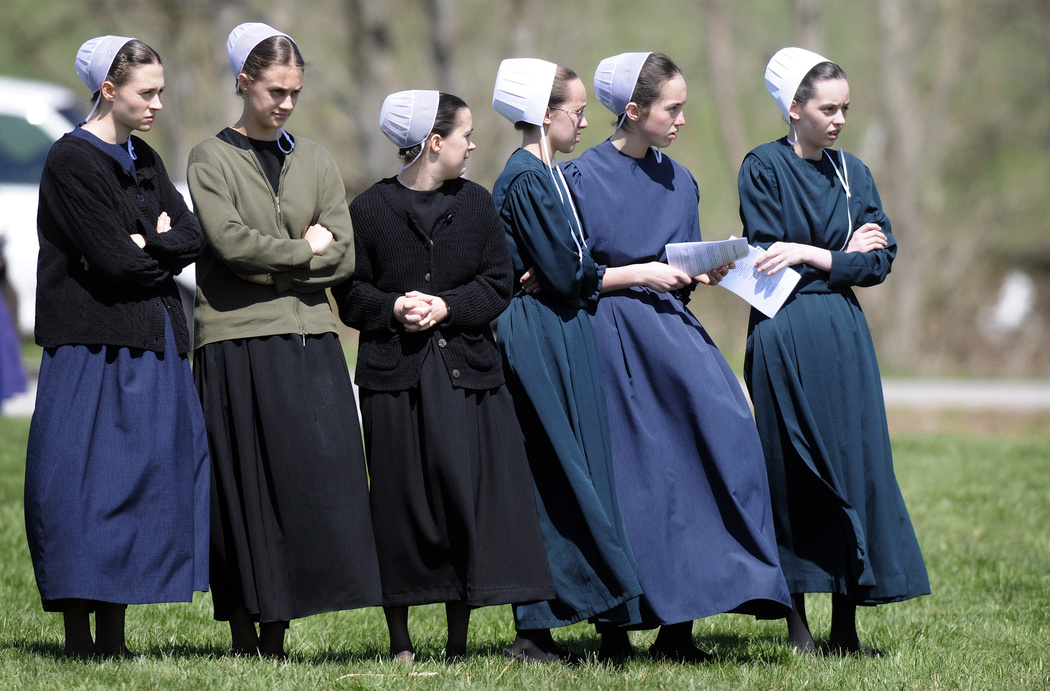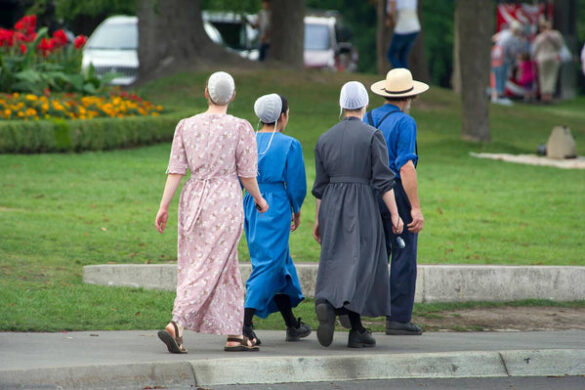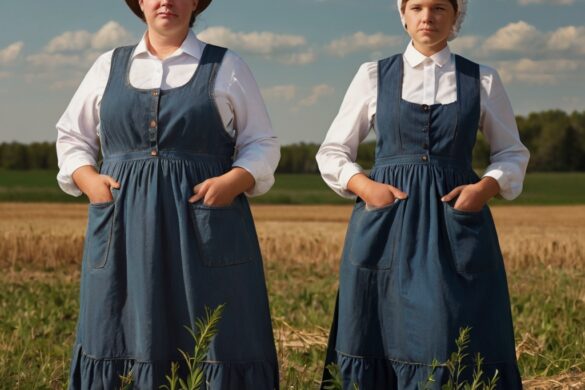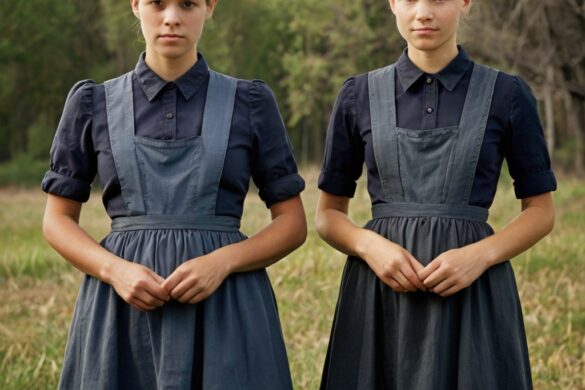Mennonite women follow rules rooted in religious beliefs that have shaped their communities through generations. Canadian statistics show around 57,000 Low-German-speaking Mennonites call Canada home. Alberta houses 12,000 to 15,000 of them, while Manitoba and Ontario accommodate the rest. These communities stand apart from modern society through their unique practices.
Mennonite women’s appearance reflects their faith – they cover their heads with prayer veils and choose simple clothing without makeup or jewelry. Their lifestyle choices come directly from their Bible interpretation, as their identity centers on religious beliefs. These women serve others with dedication, whatever their nationality or faith. The history books tell us something interesting – Anabaptist women, the Mennonites’ ancestors, stepped into leadership roles their contemporaries couldn’t access.
Many people wonder about the specifics of a Mennonite woman’s life. The rules that guide their choices often surprise outsiders. This piece delves into the guidelines that shape their world – from how they dress and behave in public to their marriage customs and educational paths. You’ll discover the unspoken rules that define their daily lives, whether you’re curious about Mennonite beliefs or want to understand these women’s experiences better.

1. Modesty in Dress and Appearance
Mennonite women have followed distinct dress codes that value modesty and simplicity for hundreds of years. These customs go beyond cultural traditions. They represent deep expressions of faith that differ among communities. The way Mennonite women dress reveals their values, community bonds, and connection with God.
Why long skirts and head coverings matter
Many Mennonite women wear a prayer cap or covering as a visible sign of their faith. This custom comes from Biblical teachings in 1 Corinthians 11, where Paul tells women to cover their heads during prayer and prophecy. Many Mennonite groups ask women to wear prayer veils all the time because they believe in the call to “pray without ceasing”.
Long skirts and dresses mean more than just clothing choices – they show Biblical modesty in action. Conservative Mennonite groups often point to 1 Timothy 2:9-10, which asks women to “dress modestly, with decency and propriety”. These groups don’t allow women to wear pants or shorts. They see these as men’s clothes that go against Biblical rules about cross-dressing.
More traditional groups often wear the cape dress. It has an extra layer of fabric over the chest to hide a woman’s shape. This practical piece lets women work comfortably while staying modest. Some even have special openings under the cape to make breastfeeding easier.
How modesty reflects religious values
Modest clothes mean much more than just rules to Mennonite women. Simple, humble clothing shows lives focused on faith and community instead of worldly things. Mennonite women skip fancy hairstyles, makeup, and jewelry to show they reject vanity.
A Mennonite woman puts it this way: “Dressing simply isn’t adhering to a rule or squishing myself into a box that dictates what a woman can be. Dressing simply is a way of saying and of feeling deep within myself that I am worth more than my clothes or my sex appeal”. Her words show how modest dress pushes back against society’s focus on looks.
The head covering stands for a woman accepting God’s chain of authority. God leads Christ, Christ leads man, and man leads woman. Some Mennonite women believe their covering gives them spiritual protection. They say “God’s ministering angels, and even Satan’s angels of darkness, take note of my headship veiling”.
Variations across Mennonite communities
While modesty stays important, dress rules differ substantially among Mennonite groups. Conservative groups have strict rules about clothing styles, colors, and patterns. Modern congregations let women decide what modest means to them.
Some groups only allow dresses. Others let women wear skirts with blouses. Head coverings range from small lace doilies to larger bonnet-style pieces. Each style often shows which group a woman belongs to. Small differences in dress and covering styles carry deep social meaning. Members might see others as “more Godly” or “less Godly” based on how conservative their dress is.
Over the last century, many Mennonite groups have slowly changed their dress standards. A woman from Denbigh, Virginia remembers the 1960s when it seemed like “every woman did what was right in her own eyes” about dress. These changes happened quietly, with women following respected community members rather than church leaders.
2. Silence and Submission in Public Spaces
Traditional gender expectations in Mennonite communities go beyond clothing choices. Women must follow behavioral rules about their voices in public spaces. These rules about silence and submission are central to mennonite rules for women. Many people outside these communities find it hard to understand these boundaries.
The biblical basis for silence
Biblical interpretations shape the way Mennonites view women’s roles. They often quote 1 Timothy 2:11-12: “Let a woman learn in silence with all submission. I do not permit a woman to teach or to have authority over a man; she must be silent”. Another important passage comes from 1 Corinthians 14:34-35, which tells women to “keep silence in the churches”.
Conservative Mennonite groups take these passages at face value. They believe God created specific roles for men and women. One church statement puts it this way: “The divinely ordained role of woman is to complement man, not to compete with him”. The hierarchy becomes clearer in 1 Corinthians 11:3, which states that “the head of a woman is the man”.
Many Mennonite congregations don’t allow women to teach men or hold authority over them. Women should only take part in activities that respect proper gender hierarchy—at church, home, or in society.
How this rule is taught to young girls
Young Mennonite girls learn about submission through teaching and daily life. A woman’s behavior reflects her family’s honor, so female actions need “close scrutiny”. This watchfulness helps maintain community standards and biblical ideas about proper womanhood.
Some communities limit what women can know. They believe this helps ensure women “would be kept silent and would not question any decisions that were made”. This practice aligns with 2 Thessalonians 2:15, which tells believers to “stand fast and hold the traditions which you were taught”.
Young girls also learn by watching respected women in their community. Many Mennonite women have learned “to be silent and submissive,” which people see as good qualities. This training affects more than just speaking. Men make most important family and church decisions, while women can only share their thoughts privately with their husbands.
Modern interpretations and resistance
Some Mennonite communities have changed their views on women’s roles. Critics say traditional interpretations have “conditioned women in Mennonite churches to be silent and submissive” in ways that limit their growth. Some women say they must “hide ourselves or make ourselves smaller” because of these expectations.
Women’s sewing circles became the first form of organized resistance. These groups grew into the “Women’s Missionary and Service Commission”. They gave women limited leadership opportunities, though at first they “struggled with opposition from church members who objected to the idea of women leading” even all-female groups.
Different Mennonite communities now handle these issues differently. Some keep strict rules – women can’t read scripture in public or join mixed-gender discussions. Others let women “teach other women in Sunday school or Bible studies” and “teach children” but still can’t have authority over men. Progressive communities welcome fuller participation, believing strict gender roles might go against Jesus’ “radical call for wholeness for all”.
Each community finds its own balance between scripture and modern life as they decide what mennonite women can do in public. This balance between old and new continues to evolve.

3. Marriage, Motherhood, and Gender Roles
Traditional Mennonite family life builds on clear gender roles that guide women’s approach to marriage and motherhood. Marriage means more than just a personal bond – it’s a covenant made within the church community where both spouses know what’s expected of them.
Expectations around early marriage
Young marriages remain common in traditional Mennonite communities. Women often marry at 18 or 19 years old, and some communities used to accept even younger marriages. Some African Mennonite communities still accept marriages at 16 or 17.
Dating in these communities looks nothing like mainstream society. Most communities avoid conventional dating and prefer marriage-focused courtship. A forum participant explained that Holdemans strongly discourage dating, but they support “dating for marriage”. Young people usually start courting around 18, and they expect to marry by 19-20.
Mennonites see marriage differently from the secular world. Their church doctrine states, “We believe that God intends marriage to be a covenant between one man and one woman for life”. This belief shapes everything from how people court to what they expect in marriage.
The role of women in raising children
Mennonite women find their core identity and purpose in motherhood. These communities see children as “a blessing directly from God”. Many traditional groups reject family planning and let God decide their family size.
In the mennonite lifestyle, mothers take care of raising children. A mother from a conservative community explained it simply: “Homemaking for mothers is normal and expected. A mom doesn’t hold the double pressure of working outside the home plus keeping up with housework”.
Mothers teach their children about body boundaries. One Mennonite mother shared, “One of many mantras in our home is, ‘You get to choose who touches your body and how'”. They also pass down Biblical principles and cultural traditions to their children.
What can’t a Mennonite woman do in marriage?
Mennonite rules for women in marriage follow traditional gender hierarchy. The husband leads the household and makes final decisions. Men work outside as family providers, while women typically stay home.
Each gender has specific household duties – indoor chores belong to girls, outdoor work to boys. Conservative congregations don’t let women teach or participate in services beyond singing. These roles come from their religious beliefs about marriage.
These limitations can create tough situations. Research shows that Mennonite women who face abuse often stay in unhealthy marriages because they follow traditional religious beliefs that support hierarchical marriages and stress permanent unions. Church teachings about submission and forgiveness can make women more vulnerable by promoting “passive acceptance” of mistreatment.
4. Education and Career Limitations
Educational expectations for Mennonite women have changed dramatically in a variety of communities, showing different interpretations of religious values and women’s roles. The relationship between tradition and chance has shaped women’s education throughout history.
Traditional views on women’s education
Mennonite women’s educational paths often face strict limits. Girls in some conservative communities can only work between ages 16-20, before they marry and devote themselves to household duties. This short window makes it nowhere near possible to pursue higher education or build career skills. The challenges grow even more severe in international Mennonite communities. Rural Mennonite congregations in Congo report that up to 80 percent of adult women cannot read or write.
Stories of women who pursued higher learning
Many Mennonite women have broken through these barriers to achieve advanced education. They now study to become doctors, nurses, teachers, and scientists. Medicine stands out as a field where Mennonite women have made their mark by founding hospitals and developing new disease treatments. Their academic success reaches beyond medicine too. Two Mennonite women joined a team that won an international codebreaking competition in 2022. One studied engineering while the other pursued mathematics.
Balancing faith and ambition
Mennonite women often struggle to balance career goals with religious expectations. One woman put it this way: “We often polarize women’s abilities with their nature, i.e., you can’t be ambitious or have a killer instinct in business and be a nurturer”. This false divide holds back women’s full potential.
Women in church leadership face extra challenges. A woman with 25 years of experience in Mennonite church leadership described running into “barriers of whiteness, patriarchy and colonialism at every step”. Some people still promote women’s education even without specific career plans. They believe college shows women possibilities they “never thought of”.
5. Technology, Media, and the Outside World
Technology creates unique tensions in mennonite lifestyle, and different communities take various approaches to deal with it. Communities don’t treat technology like other aspects of faith practice – they see it more as a spectrum rather than a set of strict rules.
Rules around internet and phone use
Mennonite groups handle technology restrictions very differently. Old Order Mennonites stick to their traditional practices and stay away from social media, much like their plain dress customs. Progressive Mennonite Church USA congregations take a different path – they find ways to blend faith with modern tools and often use digital platforms for Bible studies or church communications.
The community comes together to make technology decisions. Most groups make a clear distinction between business-related “useful technology” and entertainment devices. Some congregations have come up with creative solutions – David Martin Mennonites keep their computers in barns or workshops but don’t allow them inside homes. The Markham-Waterloo Mennonites built their own server to control internet access.
How some women use social media for ministry
Mennonite women have started to use digital tools more actively for ministry work. Women leaders at a recent Mennonite Church USA conference talked about using digital technology thoughtfully. Several women pastors welcome changes through phone use and digital outreach.
Social media gives women a platform to share Bible teachings and spread faith messages. Pastor Beny Krisbianto believes that looking at congregation members’ Facebook pages helps understand “what’s going on in their life in that moment” and improves pastoral care.
Navigating modern life while staying ‘separate’
Modern mennonite rules for women about technology reflect the biblical message to be “not conformed to this world” (Romans 12:2). This creates real challenges since people need digital knowledge for taxes, banking, jobs, and dealing with government services.
Mennonite women now balance their need to stay separate from worldly influences with practical needs. Each community’s approach to technology shows how they try to stay true to their faith while living in today’s world.
Mennonite communities offer a compelling look at how religious traditions blend with modern life. The women in these communities guide their lives through complex rules about dress, behavior, family roles, education, and technology use. Their practices come from Biblical interpretations rather than random rules.
These communities exist on a spectrum rather than following one set of rules, as shown by the differences between various Mennonite groups. The conservative groups stick to traditional gender roles, modest dress codes, and limit women’s public participation. Progressive congregations, however, give women more freedom to pursue education, careers, and religious leadership roles.
Many women find deep meaning within these structures. They think over modest dress as a statement against society’s focus on looks. Some take leadership roles through women’s organizations or ministry work. Mennonite women showed remarkable strength and helped others whatever their nationality or religious beliefs.
The balance between tradition and change shows up in every part of Mennonite women’s lives. Their prayer coverings represent both submission to authority and spiritual protection. The community recognizes which modern tools to use rather than rejecting them outright. Women can pursue professional careers in medicine and education, though their choices might be limited.
These contrasting elements reveal a key truth about Mennonite communities. They know how to keep their religious values while carefully adapting to changing times. Mennonite women, whether traditional or progressive, continue to build their identities where faith, community expectations, and personal beliefs meet.
Here are some FAQs about the mennonite rules for women:
What restrictions do Mennonites have?
Mennonite restrictions vary by group but often include limitations on technology, entertainment, and fashion choices. When considering what rules do mennonite women have, these typically involve modest dress codes and defined roles within both the family and church community.
At what age do Mennonite girls marry?
Mennonite girls typically marry in their late teens or early twenties, similar to many conservative religious communities. The specific mennonite rules for woman regarding marriage age can vary between different Mennonite groups and families.
Are Mennonites allowed to marry non-Mennonites?
More conservative Mennonite groups typically discourage or prohibit marriage with non-Mennonites to preserve their faith and traditions. This restriction is part of the broader framework of what can’t a mennonite woman do in traditional communities regarding partner selection.
Can Mennonites have two wives?
No, Mennonites cannot have two wives as they strictly adhere to monogamous marriage practices based on their interpretation of biblical teachings. This prohibition is consistent across all groups and is included in the mennonite rules for woman and men regarding marriage.
What can Mennonites not eat?
Most Mennonites have no specific dietary restrictions beyond general Christian principles of moderation. However, when considering what rules do mennonite women have regarding food preparation, they often follow traditional cooking methods and emphasize home-cooked meals.
What is the 7 7 7 rule in marriage?
The 7 7 7 rule is a modern relationship concept suggesting couples go on a date every 7 days, take a weekend trip every 7 weeks, and a vacation every 7 months. This contemporary idea is unrelated to traditional religious practices and doesn’t reflect what can’t a mennonite woman do in her marriage.
Do Amish ladies wear bras?
This question about Amish undergarments is not applicable to Mennonite practices, as these are distinct religious groups with different traditions. The mennonite rules for woman regarding undergarments are generally private matters not typically discussed publicly.
What must an Amish bride do on her wedding night?
This question specifically concerns Amish traditions rather than Mennonite practices. While both groups share Anabaptist roots, the specific mennonite rules for woman regarding wedding nights are private matters that vary between communities and families.




